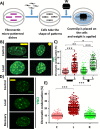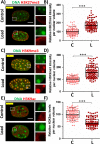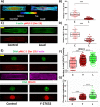Compressive force induces reversible chromatin condensation and cell geometry-dependent transcriptional response
- PMID: 30256731
- PMCID: PMC6333178
- DOI: 10.1091/mbc.E18-04-0256
Compressive force induces reversible chromatin condensation and cell geometry-dependent transcriptional response
Abstract
Fibroblasts exhibit heterogeneous cell geometries in tissues and integrate both mechanical and biochemical signals in their local microenvironment to regulate genomic programs via chromatin remodelling. While in connective tissues fibroblasts experience tensile and compressive forces (CFs), the role of compressive forces in regulating cell behavior and, in particular, the impact of cell geometry in modulating transcriptional response to such extrinsic mechanical forces is unclear. Here we show that CF on geometrically well-defined mouse fibroblast cells reduces actomyosin contractility and shuttles histone deacetylase 3 (HDAC3) into the nucleus. HDAC3 then triggers an increase in the heterochromatin content by initiating removal of acetylation marks on the histone tails. This suggests that, in response to CF, fibroblasts condense their chromatin and enter into a transcriptionally less active and quiescent states as also revealed by transcriptome analysis. On removal of CF, the alteration in chromatin condensation was reversed. We also present a quantitative model linking CF-dependent changes in actomyosin contractility leading to chromatin condensation. Further, transcriptome analysis also revealed that the transcriptional response of cells to CF was geometry dependent. Collectively, our results suggest that CFs induce chromatin condensation and geometry-dependent differential transcriptional response in fibroblasts that allows maintenance of tissue homeostasis.
Figures








Similar articles
-
Cell geometric constraints induce modular gene-expression patterns via redistribution of HDAC3 regulated by actomyosin contractility.Proc Natl Acad Sci U S A. 2013 Jul 9;110(28):11349-54. doi: 10.1073/pnas.1300801110. Epub 2013 Jun 24. Proc Natl Acad Sci U S A. 2013. PMID: 23798429 Free PMC article.
-
Chromatin changes induced by lamin A/C deficiency and the histone deacetylase inhibitor trichostatin A.Eur J Cell Biol. 2008 May;87(5):291-303. doi: 10.1016/j.ejcb.2008.01.013. Epub 2008 Apr 8. Eur J Cell Biol. 2008. PMID: 18396346
-
Nuclear deformability and telomere dynamics are regulated by cell geometric constraints.Proc Natl Acad Sci U S A. 2016 Jan 5;113(1):E32-40. doi: 10.1073/pnas.1513189113. Epub 2015 Dec 22. Proc Natl Acad Sci U S A. 2016. PMID: 26699462 Free PMC article.
-
Nuclear matrix, dynamic histone acetylation and transcriptionally active chromatin.Mol Biol Rep. 1997 Aug;24(3):197-207. doi: 10.1023/a:1006811817247. Mol Biol Rep. 1997. PMID: 9291093 Review.
-
Histone acetylation and methylation: combinatorial players for transcriptional regulation.Subcell Biochem. 2007;41:351-69. Subcell Biochem. 2007. PMID: 17484136 Review.
Cited by
-
Nuclear morphometrics and chromatin condensation patterns as disease biomarkers using a mobile microscope.PLoS One. 2019 Jul 17;14(7):e0218757. doi: 10.1371/journal.pone.0218757. eCollection 2019. PLoS One. 2019. PMID: 31314779 Free PMC article.
-
Brick Strex: a robust device built of LEGO bricks for mechanical manipulation of cells.Sci Rep. 2021 Sep 16;11(1):18520. doi: 10.1038/s41598-021-97900-5. Sci Rep. 2021. PMID: 34531455 Free PMC article.
-
Cell-matrix feedback controls stretch-induced cellular memory and fibroblast activation.Proc Natl Acad Sci U S A. 2025 Mar 25;122(12):e2322762122. doi: 10.1073/pnas.2322762122. Epub 2025 Mar 18. Proc Natl Acad Sci U S A. 2025. PMID: 40100625
-
Nuclear mechano-confinement induces geometry-dependent HP1α condensate alterations.Commun Biol. 2025 Feb 25;8(1):308. doi: 10.1038/s42003-025-07732-6. Commun Biol. 2025. PMID: 40000755 Free PMC article.
-
How enzymatic activity is involved in chromatin organization.Elife. 2022 Dec 6;11:e79901. doi: 10.7554/eLife.79901. Elife. 2022. PMID: 36472500 Free PMC article.
References
-
- Albiez H, Cremer M, Tiberi C, Vecchio L, Schermelleh L, Dittrich S, Kupper K, Joffe B, Thormeyer T, von Hase J, et al (2006). Chromatin domains and the interchromatin compartment form structurally defined and functionally interacting nuclear networks. Chromosome Res , 707–733. - PubMed
-
- Andrews S. (2010). FastQC: a quality control tool for high throughput sequence data, version 0.11.4. Available online at www.bioinformatics.babraham.ac.uk/projects/fastqc (accessed April 2017).
-
- Anwar T, Sen B, Aggarwal S, Nath R, Pathak N, Katoch A, Aiyaz M, Trehanpati N, Khosla S, Ramakrishna G. (2018). Differentially regulated gene expression in quiescence versus senescence and identification of ARID5A as a quiescence associated marker. J Cell Physiol , 3695–3712. - PubMed
MeSH terms
Substances
Grants and funding
LinkOut - more resources
Full Text Sources
Other Literature Sources

